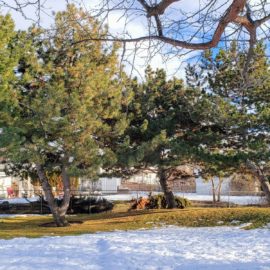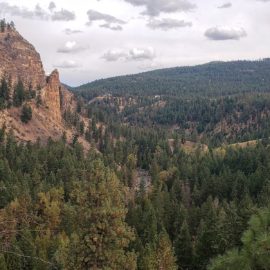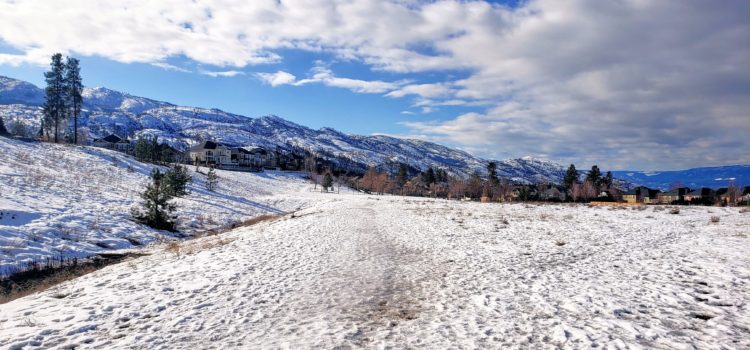
Kelowna Parks Challenge – Trip #27
This week, as part of the Kelowna Parks Challenge, I explored the relatively new community of Kettle Valley. Located in the South Mission, this neighbourhood was opened in 1996 and was designed according to new urbanist and neo-traditionalist principles. Altogether I saw a whopping eight parks!
Read on to see what I found!
The Trip
Kettle Valley is a large master-planned development that sits on a lakeside terrace south of Okanagan Mission. Not actually located in a valley, it is named after the Kettle Valley Rail Trail, which winds through the mountains to the south. New subdivisions have been opening there for the last twenty-five years and the ground has recently been cleared for the last of them.
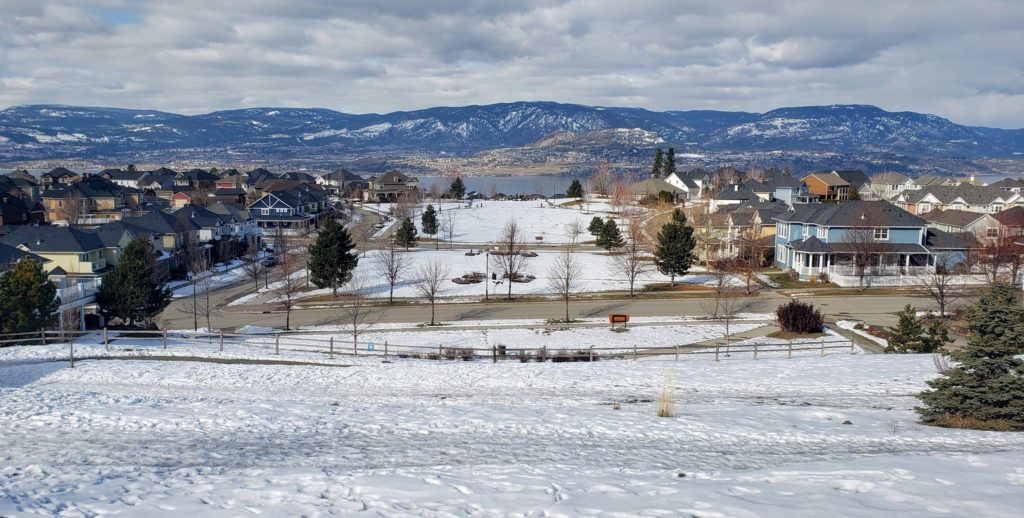
Planned with the principles of new urbanism in mind, the developers had to convince city hall to change its zoning laws in order to execute their vision. They were evidently successful, as throughout the community I saw that vision in action. In Kettle Valley, the streets are narrower and the houses are closer together, in order to de-emphasize cars and re-emphasize people. Rear lanes give access to rear garages and front doors are only a couple of metres from the sidewalk. Some houses even fronted onto parks, rather than streets.
The community was also built according to the precepts of neo-traditionalism. This was most obvious in the splendid variety of hundred-year-old house designs. Since most suburban development in Kelowna happened after the middle of the twentieth century, there are very few such houses to be found here, unless one makes a point of building them, as here.
The love for neo-traditionalist design extended to Kettle Valley’s parks, as well. Eighteenth and nineteenth-century elements were evident in several of the parks, in particular, the central axis formed by Quilchena, Providence and Mountainside Parks.
Curlew Park
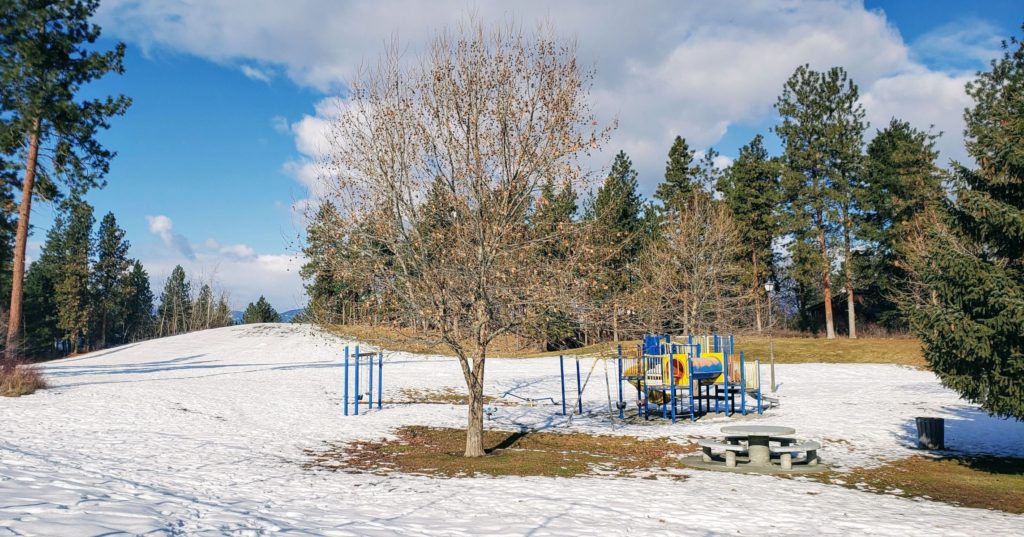
My starting point for this week’s walk was not technically part of Kettle Valley but is right next door. Curlew Park is a large neighbourhood park that sits beside the neighbourhood’s elementary school, Chute Lake Elementary. Without a fence between them, the park effectively doubles the size of the schoolyard.
In addition to a large soccer field in the middle, this park has a playground and a picnic table in its eastern corner. Delightfully, it is still edged with rolling hills and remnant pine forest, providing habitat for local animals and great places for kids to play.
Washrooms and Drinking Fountains: There is no drinking fountain in this park. There is no washroom in this park.
Dog Rules: Because this park has a playground and no trails, dogs are not allowed in this park.
Kettle Valley Sports Field
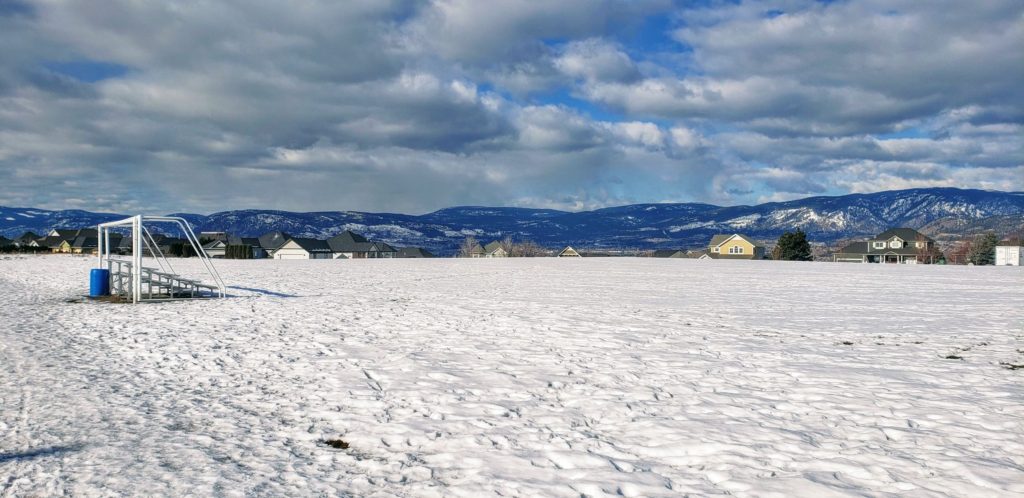
This enormous park is nearly an empty lot. Left vacant for a future middle school, a large soccer field is the only improvement here. In 2017, the city decided to build the middle school in the new Ponds neighbourhood, but the residents of Kettle Valley requested that this open space be left open.
In addition to the soccer field, this park has a wide path along its length, leading from the northeast side across into Quilchena Park, with which it blends seamlessly.
Washrooms and Drinking Fountains: There is no drinking fountain in this park. There is no washroom in this park.
Dog Rules: Because this park has no official trails, dogs are not officially allowed in this park.
Quilchena Park
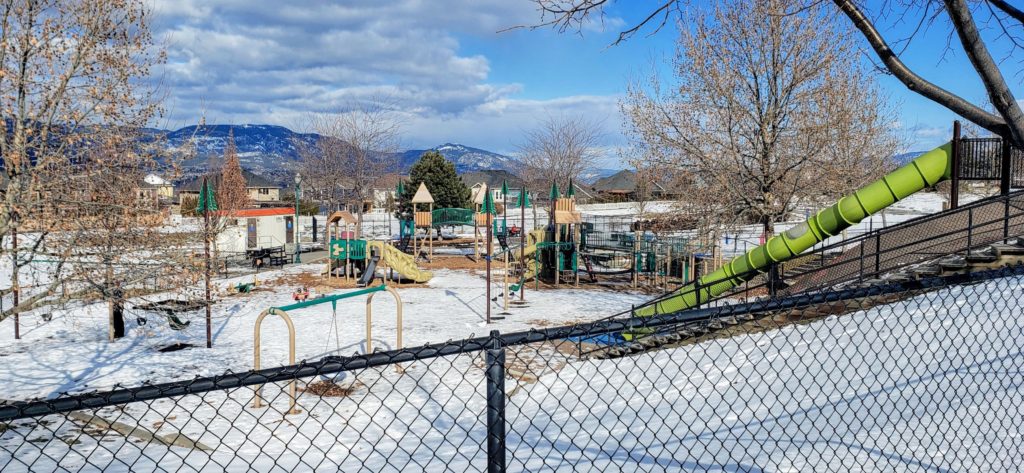
Located at the bottom of the hill from most of the community, this is a large, central park. Since it has one of Kelowna’s three waterparks, it is a destination park for the entire city. With its large hill, it is also one of the city’s best places for sledding.
In addition to these delights, this park has an extra-large playground, as well as a tennis court. A visitor can also find here a monument to the 2003 Okanagan Mountain Fire, which, among other things, burned the original playground here to the ground.
Washrooms and Drinking Fountains: I did not see a drinking fountain in this park. There is a portable washroom in this park, at the south end of the parking lot.
Dog Rules: On-leash dogs are allowed on the trails in this park, but not near the playground or waterpark.
Providence Park
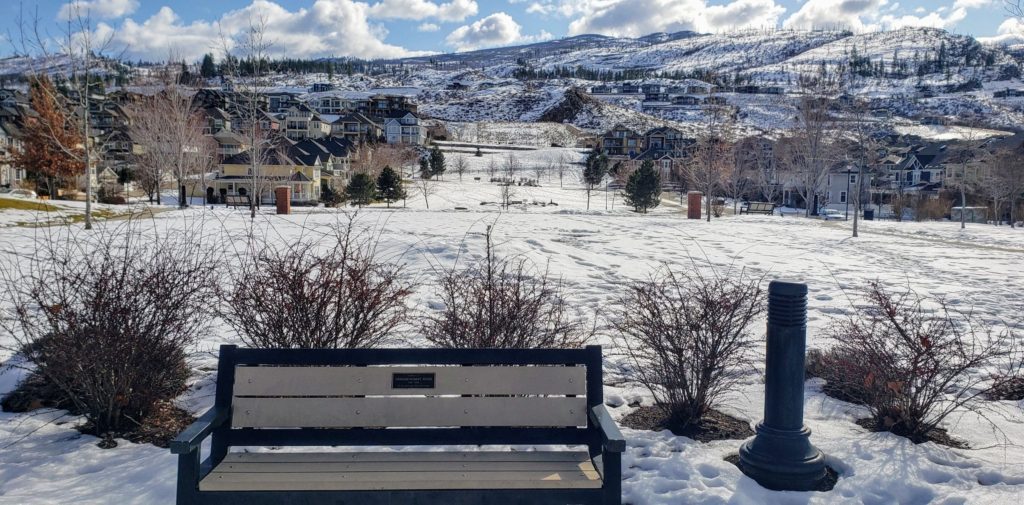
Providing the community’s central axis, Providence Park runs from Quilchena Park all the way up to Mountainside Park. A wide green carpet, its design is strongly reminiscent of eighteenth-century landscape architecture.
Though it doesn’t have any playgrounds or picnic tables, this park is lined with paved paths and dotted with plazas designed to highlight perhaps its best feature, its view over the lake to West Kelowna.
Washrooms and Drinking Fountains: There is no drinking fountain in this park. There is no washroom in this park.
Dog Rules: On-leash dogs are allowed on the trails in this park.
Mountainside Park
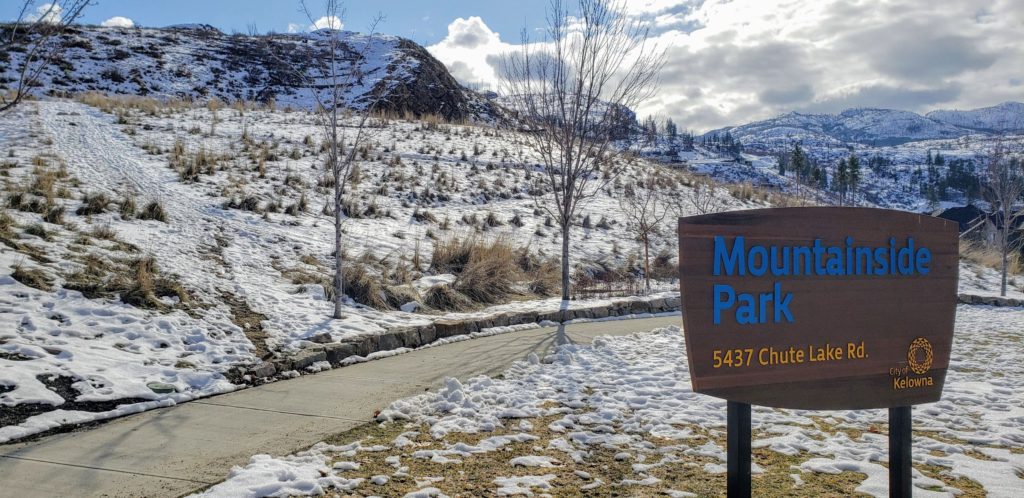
This park, located near the high point of the community was the most ‘natural’ of the parks I explored this week. For the most part, it comprises a hillside with a switchback trail leading from Chute Lake Road to Audubon Court. It is difficult to tell in the winter, but it looks like the rest of the park is covered with native grasses.
Though it doesn’t have a lot of features, this park does have a small plaza on its north side, complete with benches and an amazing view of Providence Park and Okanagan Lake beyond it. After returning home I found out there is another trail through this park on the south side of the central hill. Perhaps I’ll be able to explore it when I come through on my way to the Johns Family Conservancy.
Washrooms and Drinking Fountains: There is no drinking fountain in this park. There is no washroom in this park.
Dog Rules: On-leash dogs are allowed on the trails in this park.
Jewel Park
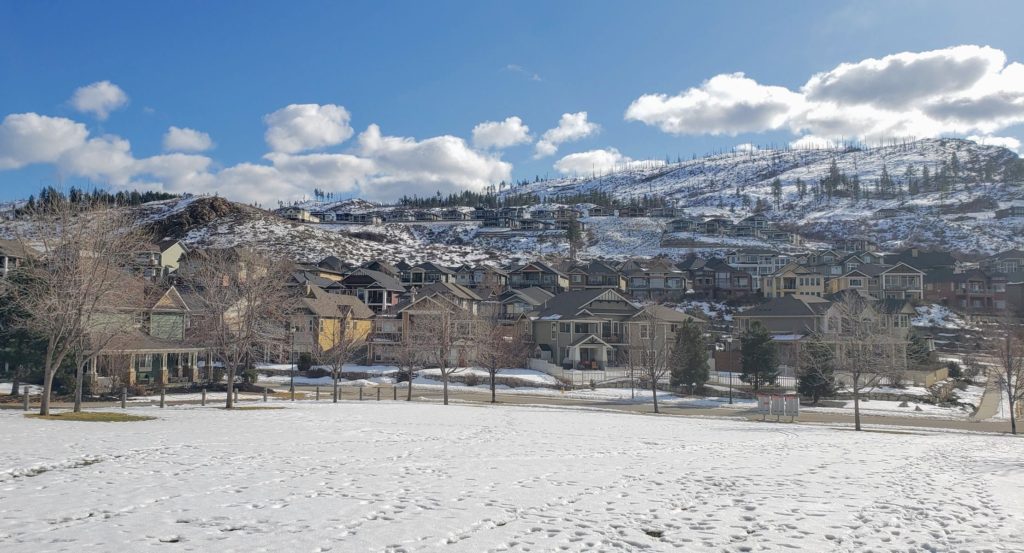
Moving away from the community’s central axis, I came to this neighbourhood park. Rectangular in shape, it nevertheless didn’t appear to have an official sports field inscribed on it. A playground in the western corner appeared to be its only improvement.
Jewel Park provides a perfect example of the new urbanist practice of having houses that front onto parks, rather than streets. Though this park has streets on its northeast and southwest sides, its other two sides are lined with charming residences.
Washrooms and Drinking Fountains: There is no drinking fountain in this park. There is no washroom in this park.
Dog Rules: On-leash dogs are allowed on the trails in this park.
Winslow Park
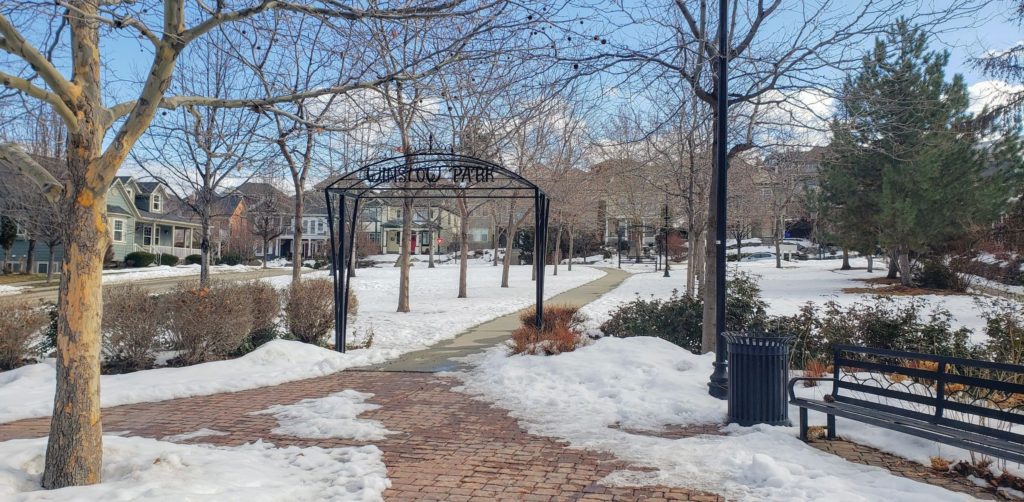
Winslow Park occupies the same position, symmetrically speaking, on the northeast side of Kettle Valley as Jewel Park does on the southwest. Nevertheless, its landscape design is very different. Instead of a large lawn, Winslow Park is dominated by a central path leading from a round plaza on the low end to a bench under an arch on the upper side.
This park is, therefore, perhaps less well suited to running and playing, but perfectly suited to just sitting and enjoying being outdoors. I can only imagine how lovely it would be to read a book or sip some iced tea in the shade of the plane tree at the centre of the plaza, once it is full with leaves.
Washrooms and Drinking Fountains: There is no drinking fountain in this park. There is no washroom in this park.
Dog Rules: On-leash dogs are allowed on the trails in this park.
Main Street Park
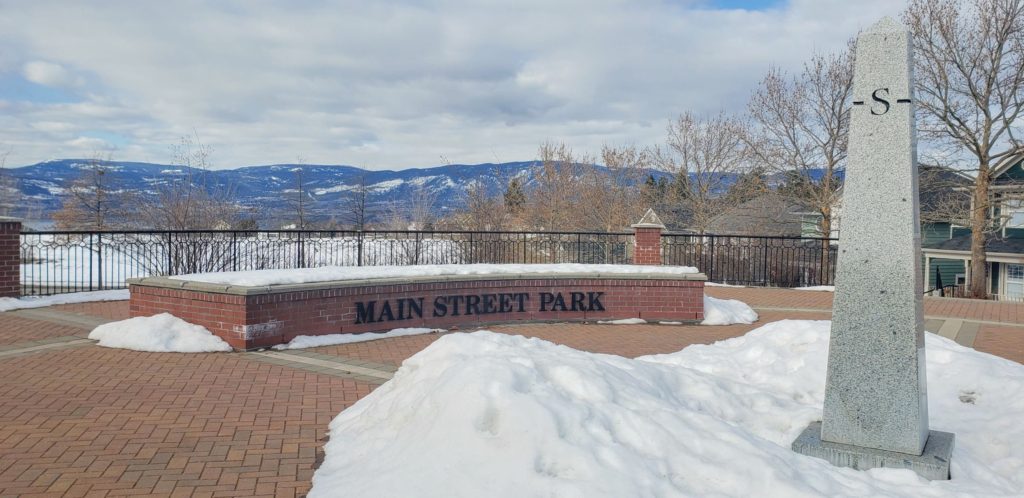
Main Street Park is located at the northwest end of Main Street, a short but important street that is home to the Kettle Valley Village Centre, the commercial heart of the neighbourhood. Given its prominent location, this park is devoted to an elevated plaza where locals can gather and visitors can get their bearings. This can be done literally by means of a central obelisk marked with the cardinal points.
On its northwest side, the park has a sloping field that sits across the street from the Kettle Valley Sports Field, providing a green connection from the Village Centre all the way around to Mountainside Park. It would provide a better view if the street between the two parks weren’t lined with trees.
Washrooms and Drinking Fountains: There is no drinking fountain in this park. There is no washroom in this park.
Dog Rules: On-leash dogs are allowed on the trails in this park.
Reflections
Master-planned Community
In a way, every neighbourhood I have visited has been planned. From the dense blocks east of Downtown, laid out in 1910, to the still-developing hillsides of Wilden, every development included a design element at an early stage. Nevertheless, the promotional literature about Kettle Valley suggested its developers had placed a higher value on the overall concept for their ideal community.
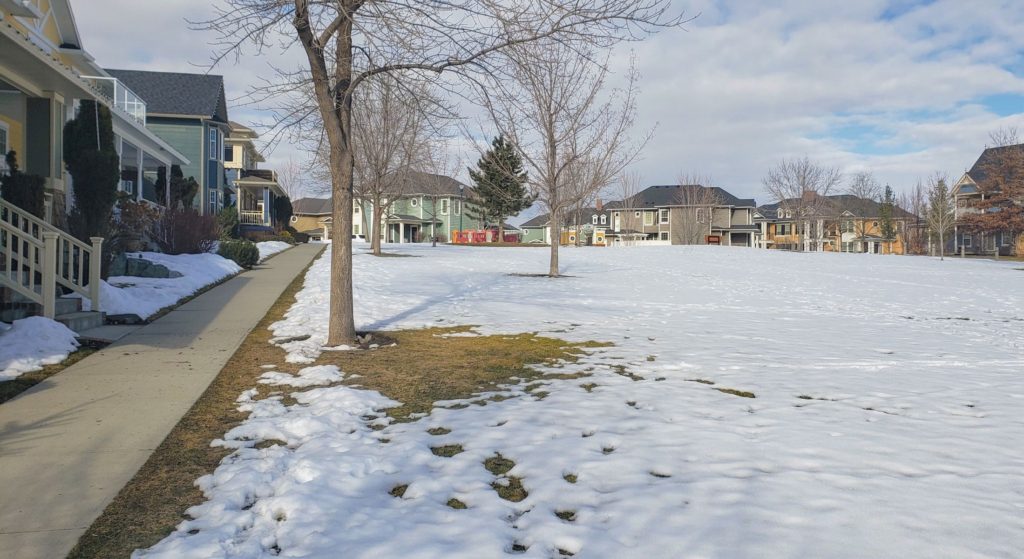
Every design school that comes around comes around at a point in historical time, so the ideas of new urbanism and neo-traditionalism that inspired the creators of Kettle Valley tell us something about the 1980s, when they first became popular. They also, however, help us understand how we got to where we are today. In the ’90s, Kettle Valley’s developers had to fight city council to be allowed to give their community new urbanist features such as narrow streets and garages in the back, while today principles such as walkability and livability are increasingly mainstream.
New urbanist principles continue to come up in Kelowna city council debates. Just last year, when the developers behind the Ponds and other edge-of-town developments fought to be allowed to continue the build-out of their new communities, the need for a critical mass of density that would provide a population to sustain local commercial zones and justify transit investment was marshalled as one of their most compelling arguments.
As interesting as it is to see these developments build out, I am also intrigued to see what will happen after that. Will future housing development be restricted to the urban centres? Will new master-planned communities on the edge of the city ever be approved again?
South Mission
This week’s adventure was my first in the territory on the south side of Okanagan Mission. For most of the nineteenth and twentieth centuries, the hillsides above the Mission were very sparsely inhabited. That land, like most of Kelowna, was pre-empted by pioneering settlers starting in the 1860s, but it wasn’t subdivided for suburban development until the latter part of the twentieth century.
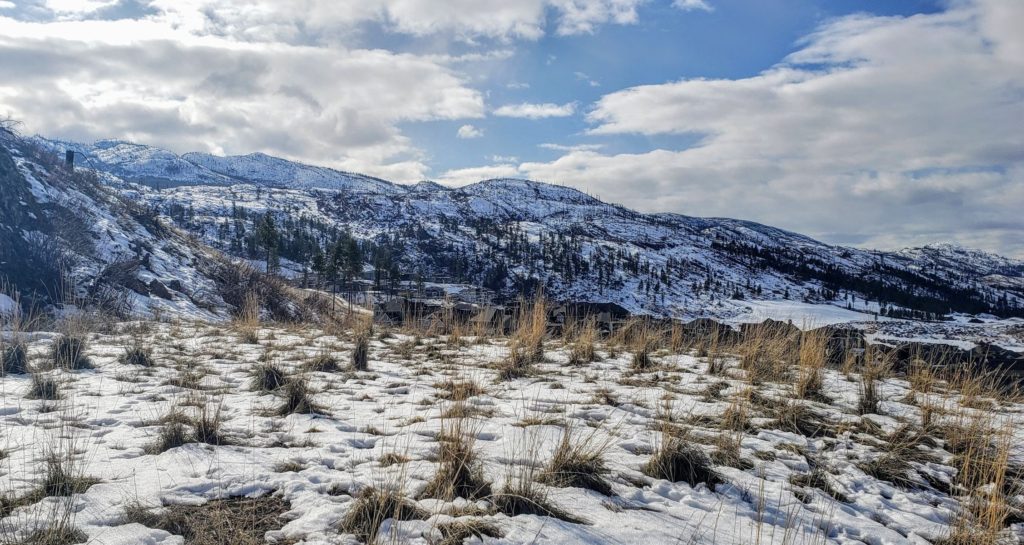
It was clear to me, from the remaining trees around Kettle Valley, that the hillside it occupies used to be covered with Ponderosa Pine forest before it was cleared for houses, meaning it had a fairly dry climate. Historically-speaking there were at least three major fires there between 1910 and 2003, and without human suppression, that type of forest burns every ten to twenty years.
Nevertheless, in the last few decades subdivision and development have continued, and even though the city has decided to limit future sprawl, those developments, like Kettle Valley, that were okayed prior to this decade, will be allowed to be built out.
Kettle Valley has been under development since 1996 and the final phase is currently under construction. I am interested to find out how it compares to the Ponds, to the northeast. That community is only partially built so I expect it to look more like Wilden, with dead-ended new roads and natural areas awaiting clearing.
Conclusions
With the addition of this week’s bonanza of eight parks, I have essentially gotten back on pace when it comes to my challenge. Including this week’s parks, I have now visited one hundred eighteen parks in two hundred twelve days, or 58% of the parks in 58% of the year.
I know I am going to have weeks in the future when I only see one large park, or even part of a park (as I with Kathleen Lake), so I intend to make more of an effort to get ahead in the next few weeks. Wish me luck!
I hope you enjoyed reading about my latest adventure, and I hope you will come back to read more!

